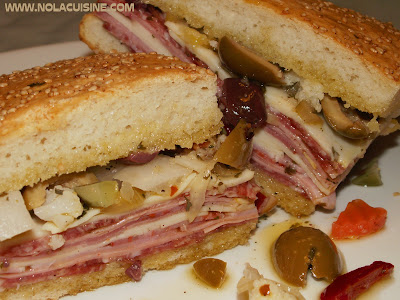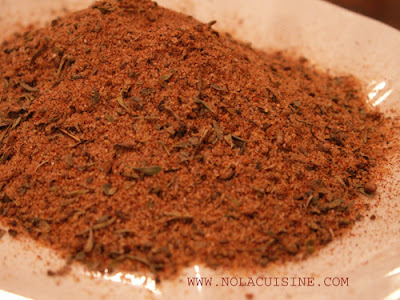 |
| From Nola Cuisine |
This is my version of the Olive Salad for the NOLA Cuisine classic sandwich, The Muffuletta! My friend Tom and I always make at least one stop at the Central Grocery on Decatur during a visit to New Orleans for Mardi Gras. You can grab a Muffuletta Sandwich at CG, a beer in a Go-Cup from the liquor store down the street, then sit up on the Riverwalk to watch the barges roll by on the Mississippi; or just flop out in the street like a common Hobo, depending on how hungry you are.
Back to the recipe, I would make this at a few days ahead, it improves with age. Use good quality olives, Hey, good quality everything, right! I’m fortunate enough to have a great Italian market, about a mile from my house called Ventimiglia’s. I also make my own Roasted Red Peppers, I find the jarred variety mushy, plus they’re super easy to make; recipe follows. This Olive Salad Recipe makes enough for one Muffuletta and a few Bruschetta (recipe follows):
Muffuletta Olive Salad Recipe
1 1/2 Cups Green Olives, Pitted
1/2 Cup Calamatta Olives (or Black) Pitted
1 Cup Gardiniera (Pickled Cauliflower, Carrots, Celery, Pepperoncini)
1 Tbsp. Capers
3 each Fresh Garlic cloves, thinly sliced
1/8 Cup Celery, thinly sliced
1 Tbsp. Italian Parsley, finely chopped
1 Tbsp. Fresh Oregano (When I have it in my garden) or 2 tsp. dried
1 tsp. Crushed red pepper flakes
3 Tbsp. Red Wine Vinegar
1/4 Cup Roasted red peppers (Recipe follows)
1 Tbsp. Green Onions, thinly sliced
Kosher Salt & Freshly Ground pepper To Taste (salt may not be necessary)
Crush each olive on a cutting board with your hand. Combine all ingredients. Cover with:
Extra Virgin Olive Oil about 1 – 1 1/2 Cups
Put into a bowl or jar, cover and let the flavors marry for about one week.
Roasted Red Peppers
Preheat the oven to 425 degrees
Place 2 Red bell Peppers (remove the blasted sticker!) on a baking sheet, place in the oven. In 15-20 minutes flip it over. Leave it in the oven for another 15-20 minutes. Remove from the oven, place in a container and cover with plastic wrap. Let stand for about 10-15 minutes, this makes the skin come off more easily. Uncover and remove all of the skin, stem and seeds, careful they’re hot! Refrigerate. Great in a number of dishes, Paella, Jambalaya, Sauteed Chorizo or Andouille, Olive salad, you name it.
Olive Salad Bruschetta
Slice a Baguette into 3/4 inch thick slices on the bias, Pop them under the Broiler until they’re golden brown. Break a Garlic clove in half and rub it onto the slices. Top with generous heaps of Olive Salad with plenty of oil & liquid. Serve immediately.
Related Posts:
Central Grocery Muffuletta
My Muffuletta Sandwich Recipe
My Muffuletta Bread Recipe
Chargrilled Pizza with Olive Salad
Here is a pic of my Muffuletta:
 |
| From Nola Cuisine |
Be sure and check out my ever growing Index of Creole and Cajun Recipes which links to all of the recipes featured here!


